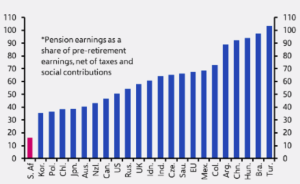Will Two-pot ultimately prove to be an own goal?
Dave Johnson
Independent Trustee
_______________________________________________________________________________________________________
Initial withdrawal focus: Potential disillusionment?
The introduction of the ‘Two-pot’ System has certainly generated much interest, but perhaps some of the most important discussion points have been missed?
 The main focus of discussion and debate has been on the initial seeding capital withdrawal of up to R30 000 per member from 1 September 2024. The fact that for most people the actual payout will be less than R30 000 due to the tax deducted, administration fees, or the 10% cap may lead to some unhappiness, and there will surely be many disillusioned retirement fund members not meeting their short term financial objectives that they were hoping to accomplish through Two-pot?
The main focus of discussion and debate has been on the initial seeding capital withdrawal of up to R30 000 per member from 1 September 2024. The fact that for most people the actual payout will be less than R30 000 due to the tax deducted, administration fees, or the 10% cap may lead to some unhappiness, and there will surely be many disillusioned retirement fund members not meeting their short term financial objectives that they were hoping to accomplish through Two-pot?
For many, Two-pot will provide some moderate relief from prevailing financial plight, and of course the proceeds of these premature withdrawals will make their way back into the economy, hopefully providing some support for a long-ailed economy.
Legislative and administrative challenges and key issues
In addition to the Two-pot withdrawal, another issue being highlighted has been the regulatory provisions, as there are still a few pieces of legislation that need to be signed into law before the process is complete.
 The preparedness of South Africa’s retirement fund administrators has also been debated.
The preparedness of South Africa’s retirement fund administrators has also been debated.
Administrators do not only have to process the various withdrawal pots/components of Two-pot, but they need to allow for savings pot withdrawals. These additional complexities come at a cost, and administrators are going to have to recover this from the members, either via increased administration costs or via a specific administration charge to process a savings pot withdrawal. South African retirement funds, already complex with numerous moving parts, have just become even more complicated and difficult to administer.
The prevailing big issues are the locking-in of retirement savings to retirement, and the annual savings pot withdrawal option.
In terms of locking in retirement savings to retirement, this has always been the case with the rules pertaining to retirement annuities.
As pension and provident funds are also vehicles for retirement savings, the inconsistency with retirement annuities is questioned. While it’s reasonable to not change the rules on existing assets, and permit the vesting component for pre-September 2024 savings, aligning with retirement annuities would make sense, particularly in a country where only 6% of retirements are properly funded for, and where the government does not have the funds to meaningfully provide state pensions.
Financial emergencies: A questionable solution
 As regards accessing retirement funds ahead of their due date, it is acknowledged that individuals may face unexpected financial emergencies and it may be excessively harsh that they cannot feed their families while they’re looking at assets locked up in a retirement plan. The sustainability effectively allowing 1/3 of member’s savings contributions to be withdrawn each year is however questionable.
As regards accessing retirement funds ahead of their due date, it is acknowledged that individuals may face unexpected financial emergencies and it may be excessively harsh that they cannot feed their families while they’re looking at assets locked up in a retirement plan. The sustainability effectively allowing 1/3 of member’s savings contributions to be withdrawn each year is however questionable.
Of course the best solution would be to only allow withdrawals for true emergencies, but the burden of this responsibility on retirement fund trustees to review all applications would make the existing death claim process (an already complex and difficult task) seem like a walk in the park.
Member responsibility and potential for abuse
Two-pot responsibility is therefore in the hands of each member, trusting them to not abuse the system. Sadly we know that many members will not act responsibly, cashing out their savings pot each year, and of course then only saving two-thirds of their contributions.
South Africa already has a retirement savings problem with the average fund contribution at just over 12% of pensionable salary. If a fund member now withdraws annually then they will only be saving 8% per annum (and admin fees and risk benefits haven’t yet been considered). Fund members, already with an ignorance-based sense of security that they ‘have a retirement fund’ have little comprehension of what 8% of pensionable salary as opposed to 12% will compound to. Is this ‘emergency’ fund access not actually (irresponsible) political capitulation in exchange for votes?
Actuarial perspective: Long-term impact and simpler solutions
The actuarial profession and others have praised the new regulations on the basis that over the longer term the lock-in provision will have a greater positive effect than the negative impact of the annual savings pot withdrawals. Currently accessed only by resignation, industry pundit’s argue that there will be a net increase in the level of retirement savings. Whilst perhaps true, there are other simpler, decisive measures which would ensure that retirement savings are preserved for retirement.
National Treasury’s initial motivation and current perception
The initial motivation for Two-pot, by National Treasury to provide for emergency (and then Covid) situations has definitely been lost, with prevailing popular context seeing this as an ‘annual bonus’. A largely unsophisticated membership is failing to appreciate the compromising long-term impact. These same financially unsophisticated members are likely to see this annual access as a type of stokvel. There are already government incentivised investments available for providing emergency funding, including tax-free savings plans.
The long-term view and missed opportunities
Tim Cohen, Business Maverick’s editor, summarised Two-pot in his ‘After The Bell’ column recently, penned it as well as anyone could, reminding us all how long term investing works. Rule one is to start early. Rule two is don’t stop. And rule three is don’t touch the pot’. His article questioned whether South Africa should actually go through with this complex, complicated, expensive, and politically slanted piece of legislation. In the light of regulatory promulgation, this was of course a hypothetical and rhetorical question. Two-pot is with us, whatever our views might be. With this understanding GTC urges all retirement fund members to be pragmatic, being financially knowledgeable and fiscally prudent.
Source: Daily Maverick
Essential changes and the need for better solutions
The locking-in of (some of) retirement savings to retirement is an essential change that had to be made. Appreciating the need to allow access to assets in emergency situations, the proposed one third of savings being allocated to an accessible savings pot is going too far. There needs to be a mechanism to ensure these are emergency withdrawals only, or long term retirement savings will suffer. There is a need to align retirement savings vehicles with the retirement savings requirements and to encourage the use of other financial vehicles for the shorter term needs and emergencies. We missed a trick here!
Note from the CEO editor: Dave Johnson is an independent trustee and, whilst GTC shares many of the opinions passed, this is Dave’s article.
We invite you to discuss this with either your GTC retirement benefit consultant or one of the GTC MAPS team.








